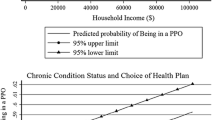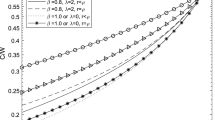Abstract
This paper develops a dynamic framework for analyzing an individual’s choice between a Preferred Provider Organization (PPO) and a Health Maintenance Organization (HMO) under uncertainty regarding future health. We explicitly model health as a stochastic process whose fluctuations arise from three sources, one deterministic and two stochastic. Health evolves over time with a downward drift over the lifespan. In addition, health is subject to small, mean zero random fluctuations. Finally, there exists a small possibility every period of a serious illness resulting in a large, discrete fall in health. Under this characterization of health uncertainty, we develop a Real Options model valuing flexibility in health plan choice which takes into account the embedded flexibility to receive coverage for out-of-network care if the PPO health plan is chosen. Our model suggests that greater health problems increase the value of the option to go out of network for the PPO enrollee.





Similar content being viewed by others
Notes
Merton cites two papers in this area, but neither pertains directly to the household’s choice of health plan. One (Hayes et al. 1993) discusses futures markets for health care claims, while the other (Magiera and McLean 1996) applies real options analysis to hospital capital investment decisions. Capp et al. (2003) use an option analogy to characterize the markets in which HMOs act as “intermediaries [that] sell networks of suppliers to consumers who are uncertain about their needs” as “option demand markets” but do not deal with PPOs. Finally, Gerard Wedig (2010) argues that Selective Contracting (SC) practiced by HMOs limit the choices of consumers, which has led to lower enrollment trends. His analysis is restricted to one dimension of choice, the available hospitals in the network for a consumer, conditional on their type of illness. While he does not explicitly model the out-of-network option available under a PPO, his results suggest that choice of hospitals under a plan is an important determinant of enrollment. Since the out-of-network option is exercised less often the larger the in-network choice set, our results corroborate his findings.
Even though we use an infinite horizon model, a finite life is approximated by the stipulation of a downward drift in health status, h, so that expected health approaches zero in the long-run. Standard models of utility maximization over an infinite horizon with a positive discount rate employ a similar approximation, since rewards from periods very far in the future approach zero.
While the model is mathematically much easier to solve in a continuous time framework, doing so obscures some of the subtleties of timing issues. A seamless and immediate transition between regimes is not a realistic scenario, given that employers and health plans generally allow a change in health plan once a year. Qualitatively however, the optimization problem remains the same, since the agent makes the stay or switch decision per unit of time, whether that unit is a year, or a given instant.
Due to data limitations, we do not treat income as stochastic in this model. An interesting extension of the model would be to introduce uncertainty about the evolution of income with income varying with health status, that is, with capacity to work.
In reality, the agent may only have some idea of the distributions of these parameters and not their exact values. As with most economic models exercises, we make this simplifying assumption to keep the model tractable.
This simplifying assumption makes no significant qualitative difference in the model, as will be clear from the theoretical solution.
The switch from a PPO to an HMO based on health fluctuations would be a rare event, given that income rises and health tends to fall over the lifespan. We therefore expect the value of the corresponding option to be close to zero. This expectation was confirmed in the computational results.
Modeling the choice of health plan in this manner is in the spirit of Dixit’s (1989) work on the entry and exit problem of a competitive firm. In the entry-exit case, the variable driving the decision is the price of the output. In the traditional analysis, the threshold price for entry is minimum average total cost, and the threshold price for exit is minimum average variable cost. (These will be equal in the long-run, of course, as all costs become variable.) At prices that fall between the minimum ATC and AVC, there is a region of inactivity: firms that are in the market stay in the market, while firms that are out of the market stay out of the market. Dixit shows that this traditional approach implicitly assumes that firms believe with certainty that current prices will prevail forever. When firms take account of the uncertainty of future prices, the region of inactivity widens.
In reality, an HMO enrollee can go out of network at their own expense. We assume this cost to be prohibitively high and do not model that decision.
A number of possible complications that are beyond the scope of the present work deserve mention. Uncertainty could be introduced into the relationship between health care and health. In particular, out-of-network care could be modeled as increasing the expected value of health after a health shock, rather than improving health with certainty. Furthermore, a more realistic model might recognize that diseases that decrease health by similar amounts can respond differently to treatment—some diseases are curable and others are not. Terminal illness, which would increase the value of α, could also be modeled.
Using the terminology for differential equations, β 1 is the solution to the auxiliary equation the \( \alpha \beta + \frac{1}{2}{\sigma^2}\beta \left( {\beta - 1} \right) + \left( {\lambda - \rho } \right) - \lambda {\left( {1 - \phi } \right)^\beta } \) which must be solved numerically.
In this case, we do not constrain the coefficient of the negative or positive root to be zero.
For a thorough treatment of these conditions, refer to Dixit and Pindyck (1994) and Dixit (1994). A simple interpretation of these conditions is that we are imposing continuity (value matching) and differentiability (smooth pasting) at the thresholds. For example, the two conditions at h * PH would be V(h * PH, HMO) = V(h * PH, PPO)- C s and V ′ (h * PH, HMO) = V ′ (h * PH, PPO). We also impose a super-contact condition at h * ON ; we do not face a switching cost between in-network and out-of-network care, but pay a per-period cost of paying for going out of network, that is included in the value function of going out of network for a PPO enrollee. See Wirl (2008) for a discussion.
Note that A 3 β 3 is the option value of switching back to an HMO from a PPO, which is an unlikely choice. Our numerical solution for A 3 is very close to zero, confirming this intuition.
This aspect of the model may seem less counterintuitive if the reader considers how advanced age and a frail state of health affect the value of health interventions more generally. For example, a frail elderly person might be more likely to choose to forgo aggressive chemotherapy or complex surgery than would be a younger and stronger individual.
References
Bellman, R. (1954). Some problems in the theory of dynamic programming. Econometrica, 22(1), 37–48.
Boyer, M., Gravel, E., & Lassere, P. (2004). Real options and strategic competition, a survey, Economics and CIRANO, University of Montreal, Working Paper.
Black, F., & Scholes, M. S. (1973). The pricing of options and corporate liabilities. Journal of Political Economy, 81(3), 637–654.
Capps, C., Dranove, D., & Satterthwaite, M. (2003). Competition and market power in option demand markets. RAND Journal of Economics, 34(4), 737–763.
Dixit, A. (1989). The entry and exit decisions under uncertainty. Journal of Political Economy, 97(3), 620–638.
Dixit, A. (1994). The art of smooth pasting. Harwood Academic Publishers.
Dixit, A., & Pindyck, R. S. (1994). Investment under uncertainty. Princeton University Press.
Enthoven, A. C. (2005). The U.S. Experience with Managed Care and Managed Competition, Wanting It All: The Challenge of Reforming the U.S. Health Care System, Federal Reserve Bank of Boston, 97–117.
Gold, M. C. (2008). Medicare Advantage in 2008 Henry J. Kaiser Family Foundation Medicare Issue Brief, June, 2008, II–III.
Hayes, J. A., Cole, J. B., & Meiselman, D. I. (1993). Health insurance derivatives: the newest application of modern financial risk management. Business Economics, 28(2).
Hurley, R. E., Strunk, B. C., & White, J. S. (2004). The puzzling popularity of the PPO: PPOs have overtaken HMOs as the most popular health benefit option among U.S. workers-to the surprise of many analysts. Health Affairs, 23(2), 56–68.
Kaiser Family Foundation (2010). Employer Health Benefits 2010 Annual Survey, available at http://ehbs.kff.org.
Kreier, R. (2006). Economic theory and political reality: managed competition and U.S. health policy. Politics & Policy, 34(3), 579–605.
Magiera, F. T., & McLean, R. A. (1996). Strategic options in capital budgeting and program selection under fee-for-service and managed care. Health Care Management Review, 21(4), 7–17.
Merton, R. C. (1973). Theory of rational option pricing. Bell Journal of Economics and Management Science, 4(1), 141–183.
Merton, R. C. (1997). Applications of option-pricing theory 25 years later. Nobel Lecture, December 9 1997.
Sengupta, B. (2009). Real Options and Migration: Undocumented Workers and their Choices: The Case of Mexican Migration to the United States and Rural to Urban Migration in Developing Countries. Lambert Academic Publishing.
Schwartz, E. S., & Trigeorgis, L. (Eds.) (2001). Real options and investment under uncertainty. MIT Press.
Strombom, B. A., Buchmueller, T. C., & Feldstein, P. J. (2002). Switching costs, price sensitivity and health plan choice. Journal of Health Economics, 21(5), 89–116.
Trude, S. (2000). Who Has a Choice of Health Plans? Center for Studying Health System Change Issue Brief, no. 27, 2–4.
United States Bureau of the Census (2010). Income, Poverty, and Health Insurance Coverage in the United States: 2009, 20–24 Available at http://www.census.gov/prod/2010pubs/p60-238.pdf.
Wedig, G. (2010). Consumer Choice and the Decline in HMO Enrollments, Working Paper Series, Social Science Research Network, June 7, 2010.
Wirl, F. (2008). Reversible stopping implies super contact. Computational Management Science, (Oct 2008), 393–401.
Author information
Authors and Affiliations
Corresponding author
Rights and permissions
About this article
Cite this article
Sengupta, B., Kreier, R.E. A Dynamic Model of Health Plan Choice from a Real Options Perspective. Atl Econ J 39, 401–419 (2011). https://doi.org/10.1007/s11293-011-9287-x
Published:
Issue Date:
DOI: https://doi.org/10.1007/s11293-011-9287-x




